Sustainable Hygiene Solutions: Developing a Foot-Operated Door Mechanism for Communal Spaces Using TRIZ and Universal Design Principles
Abstract
1. Introduction
2. Materials and Methods
2.1. Implementation of TRIZ Method for Foot-Operated Door Mechanism
2.1.1. Design of a Foot-Operated Internal Switch Device for Doors Using TRIZ
2.1.2. Design of a Foot-Operated External Switch Device for Doors Using TRIZ
2.1.3. Design of an External Display Device for Door Usage Using TRIZ
2.2. Implementation of Ergonomics and Universal Design for Foot-Operated Door Mechanism
2.3. Survey Design
3. Results
3.1. Structure of the Foot-Operated Door Mechanism
3.2. Component Overview of the Foot-Operated Mechanism
3.2.1. Spring Housing Assembly
3.2.2. Indicator Block Assembly
3.2.3. External Pedal for Horizontal Lock
3.2.4. External Door Pedal and Connection Sleeve
3.2.5. External Pedal Mechanism
3.2.6. External Door Rotary Mechanism
3.2.7. Door-Opening Pulley Assembly
3.2.8. Horizontal Latch Mechanism
3.3. Design of the Pedal Latch Mechanism
3.4. Overview of the Foot-Operated Mechanism Design
3.5. Application of Universal Design Principles
3.6. Combination Analysis of IPA and KANO Models for Various Services of Foot-Operated Door Mechanism Design
4. Discussion
- Design of Spring Mechanism for Automatic Door Closure:
- 2.
- Design of Door Bolt Fasteners:
- 3.
- Design of Pedal Mechanism:
5. Conclusions
6. Patents
Author Contributions
Funding
Institutional Review Board Statement
Informed Consent Statement
Data Availability Statement
Acknowledgments
Conflicts of Interest
Appendix A. Summary of the 39 Engineering Parameters
| 1. Weight of moving object | 11. Stress or pressure | 21. Power | 31. Object-generated harmful factors |
| 2. Weight of stationary object | 12. Shape | 22. Loss of energy | 32. Ease of manufacture |
| 3. Length of moving object | 13. Stability of the object’s composition | 23. Loss of substance | 33. Ease of operation |
| 4. Length of stationary object | 14. Strength | 24. Loss of information | 34. Ease of repair |
| 5. Area of moving object | 15. Duration of action by a moving object | 25. Loss of time | 35. Adaptability or versatility |
| 6. Area of stationary object | 16. Duration of action by a stationary object | 26. Quantity of substance/the matter | 36. Device complexity |
| 7. Volume of moving object | 17. Temperature | 27. Reliability | 37. Difficulty of detecting and measuring |
| 8. Volume of stationary object | 18. Illumination intensity | 28. Measurement accuracy | 38. Extent of automation |
| 9. Speed | 19. Use of energy by moving object | 29. Manufacturing precision | 39. Productivity |
| 10. Force | 20. Use of energy by stationary object | 30. External harm affects the object |
Appendix B. Summary of the 40 Invention Principles
| 1. Segmentation | 11. Beforehand cushioning | 21. Skipping | 31. Porous material |
| 2. Tanking out | 12. Equipotentiality | 22. Convert harm into benefit | 32. Changing the color |
| 3. Local quality | 13. Do it in reverse | 23. Feedback | 33. Homogeneity |
| 4. Asymmetry | 14. Spheroidality–curvature | 24. Intermediary | 34. Discarding and recovering |
| 5. Merging | 15. Dynamicity | 25. Self-service | 35. Transformation of properties |
| 6. Universality | 16. Partial or excessive actions | 26. Copying | 36. Phase transition |
| 7. Nested doll | 17. Transition into a new dimension | 27. Cheap, short-lived objects | 37. Thermal expansion |
| 8. Anti-weight | 18. Mechanical vibration | 28. Replacement of mechanical system | 38. Accelerated oxidation |
| 9. Prior anti-action | 19. Periodic action | 29. Pneumatics and hydraulics | 39. Inert environment |
| 10. Preliminary action | 20. Continuity of useful action | 30. Flexible shells or thin films | 40. Composite materials |
References
- Bouchra, O.; Abdelhakim, E.L.; Nadia, B.; Btissam, A.; Wafaa, B. Environmental surfaces in healthcare setting: A great potential risk of pathogens transmission. Biomed. Res. India 2017, 28, 2398e401. [Google Scholar]
- Jaouhar, S.; El Ouali Lalami, A.; Ouarrak, K.; Bouzid, J.; Maoulouaa, M.; Bekhti, K. Infectious risk of the hospital environment in the center of Morocco: A case of care unit surfaces. Scientifica 2020, 2020, 1318480. [Google Scholar] [CrossRef] [PubMed]
- Ngonda, F. Assessment of bacterial contamination of toilets and bathroom doors handle/knobs at Daeyang Luke hospital. Pharm. Biol. Eval. 2017, 4, 193–197. [Google Scholar] [CrossRef]
- Iskandar, S.; Saif, A.; Nawas, T. Isolation of Potentially Pathogenic Bacteria from Public Service Cars Door Handles. Int. J. Curr. Microbiol. Appl. Sci. 2018, 1, 1154–1159. [Google Scholar] [CrossRef]
- Ekmekci, I.; Nebati, E.E. Triz methodology and applications. Procedia Comput. Sci. 2019, 158, 303–315. [Google Scholar] [CrossRef]
- Renev, I.A.; Chechurin, L.S. Application of TRIZ in building industry: Study of current situation. Procedia CIRP 2016, 39, 209–215. [Google Scholar] [CrossRef]
- Boavida, R.; Navas, H.; Godina, R.; Carvalho, H.; Hasegawa, H. A Combined Use of TRIZ Methodology and Eco-Compass tool as a Sustainable Innovation Model. Appl. Sci. 2020, 10, 3535. [Google Scholar] [CrossRef]
- Ghane, M.; Ang, M.C.; Cavallucci, D.; Kadir, R.A.; Ng, K.W.; Sorooshian, S. TRIZ trend of engineering system evolution: A review on applications, benefits, challenges and enhancement with computer-aided aspects. Comput. Ind. Eng. 2022, 174, 108833. [Google Scholar] [CrossRef]
- Spreafico, C. Can TRIZ (Theory of Inventive Problem Solving) strategies improve material substitution in eco-design? Sustain. Prod. Consum. 2022, 30, 889–915. [Google Scholar] [CrossRef]
- Yao, K.-C.; Chen, L.-Y.; Li, K.-Y.; Chang, Y.-N.; Xu, J.-R.; Huang, W.-L.; Ho, W.-S. An Innovative Design for Cleansing, Deodorization, and Pest Control in Drain Covers: Application of the TRIZ Method and Human Factors Engineering. Machines 2024, 12, 621. [Google Scholar] [CrossRef]
- Russo, D.; Rizzi, C.; Montelisciani, G. Inventive guidelines for a TRIZ-based eco-design matrix. J. Clean. Prod. 2014, 76, 95–105. [Google Scholar] [CrossRef]
- Yao, K.-C.; Huang, S.-H.; Li, K.-Y.; Hung, H.-C.; Xu, J.-R.; Huang, W.-L.; Ho, W.-S.; Fang, J.-S.; Tseng, Y.-J. An Eco-Innovative Green Design Method using the Theory of Inventive Problem Solving and Importance–Performance Analysis Tools—A Case Study of Marker Pen Manufacturing. Sustainability 2023, 15, 14414. [Google Scholar] [CrossRef]
- Yao, K.-C.; Li, K.-Y.; Xu, J.-R.; Ho, W.-S.; Shen, Y.-H. Application of TRIZ Innovative System Method in Rapid Assembly of Folding Chairs. Sustainability 2022, 14, 15482. [Google Scholar] [CrossRef]
- Yao, K.-C.; Huang, W.-T.; Xu, J.-R.; Huang, S.-H.; Tsai, C.-T.; Ho, W.-S.; Liao, C.-C. Application of the TRIZ Innovation System Method to Bicycle Handlebars. Machines 2023, 11, 507. [Google Scholar] [CrossRef]
- Stanton, N.A.; Salmon, P.M.; Rafferty, L.A.; Walker, G.H.; Baber, C.; Jenkins, D.P. Human Factors Methods: A Practical Guide for Engineering and Design; CRC Press: Boca Raton, FL, USA, 2017. [Google Scholar] [CrossRef]
- Guastello, S.J. Human Factors Engineering and Ergonomics: A Systems Approach; CRC Press: Boca Raton, FL, USA, 2023. [Google Scholar] [CrossRef]
- Kroemer, K.H.; Kroemer, H.J.; Kroemer-Elbert, K.E. Engineering Physiology: Bases of Human Factors Engineering/Ergonomics; Springer Nature: Berlin, Germany, 2020; Available online: https://link.springer.com/content/pdf/10.1007/978-3-030-40627-1.pdf (accessed on 29 June 2024).
- Salvendy, G.; Karwowski, W. Handbook of Human Factors and Ergonomics; John Wiley Sons: Hoboken, NJ, USA, 2021; Available online: https://reurl.cc/MOGa8K (accessed on 29 June 2024).
- Holmes-Seidle, J. Barrier-Free Design; Routledge: London, UK, 2012. [Google Scholar] [CrossRef]
- Herwig, O. Universal Design: Solutions for a Barrier-Free Living; Walter de Gruyter: Berlin, Germany, 2012; Available online: https://reurl.cc/Eja3gR (accessed on 29 June 2024).
- Arora, S.; Deshpande, A. Inclusive design—Designing barrier-free public spaces. In Design for Tomorrow—Volume 1, Proceedings of ICoRD 2021 Bombay, India, 7–10 January 2021; Springer: Singapore, 2021; pp. 133–146. [Google Scholar] [CrossRef]
- Marudut, M.R.H.; Bachtiar, I.G.; Kadir, K.; Iasha, V. Peningkatan Kemampuan Berpikir Kritis dalam Pembelajaran IPA melalui Pendekatan Keterampilan Proses. J. Basicedu 2020, 4, 577–585. [Google Scholar] [CrossRef]
- Suwartiningsih, S. Penerapan pembelajaran berdiferensiasi untuk meningkatkan hasil belajar siswa pada mata pelajaran IPA pokok bahasan tanah dan keberlangsungan kehidupan di Kelas IXb semester genap SMPN 4 Monta tahun pelajaran 2020/2021. J. Pendidik. Pembelajaran Indones. (JPPI) 2021, 1, 80–94. [Google Scholar] [CrossRef]
- Wati, E.; Harahap, R.D.; Safitri, I. Analisis Karakter Siswa pada Mata Pelajaran IPA di Sekolah Dasar. J. Basicedu 2022, 6, 5994–6004. [Google Scholar] [CrossRef]
- Lestari, F.D.; Ibrahim, M.; Ghufron, S.; Mariati, P. Pengaruh Budaya Literasi terhadap Hasil Belajar IPA di Sekolah Dasar. J. Basicedu 2021, 5, 5087–5099. [Google Scholar] [CrossRef]
- Kuo, Y.F.; Chen, J.Y.; Deng, W.J. IPA–Kano model: A new tool for categorising and diagnosing service quality attributes. Total Qual. Manag. Bus. Excell. 2012, 23, 731–748. [Google Scholar] [CrossRef]
- Tseng, C.C. An IPA-Kano model for classifying and diagnosing airport service attributes. Res. Transp. Bus. Manag. 2020, 37, 100499. [Google Scholar] [CrossRef]
- SolidCreativity. TRIZ40. Available online: https://www.triz40.com/TRIZ_GB.php (accessed on 8 August 2024).
- Technical Innovation Center Inc. 40 Principles. Available online: https://triz.org/principles/ (accessed on 10 August 2024).
- Parasuraman, A.; Zeithaml, V.A.; Berry, L.L. A conceptual model of service quality and its implications for future research. J. Mark. 1985, 49, 41–50. [Google Scholar] [CrossRef]
- Garg, A.; Dewan, A. Effects of COVID-19 on the design of the hospital. In Manual of Hospital Planning and Designing: For Medical Administrators, Architects and Planners; Springer Nature: Singapore, 2022; pp. 63–80. [Google Scholar] [CrossRef]
- Preiss, S.; Kramer, A. Foot-operated door opener to eliminate the door handle as a source of contamination. GMS Krankenhaushygiene Interdiszip. 2011, 6, 1–4. [Google Scholar] [CrossRef]
- Zaied, R. Using foot-operated tap mechanism to save water and prevent infection. In Proceedings of the 115th IRES International Conference, Medina, Saudi Arabia, 15–16 May 2018; Available online: https://reurl.cc/6dQ2rd (accessed on 29 June 2024).
- Vitting, A.; Janß, A.; Strathen, B.; Strake, M.; Radermacher, K. Further development and evaluation of a universal foot switch for diverse medical disciplines within the framework of an open integration concept for the operation theatre of the future. In Advances in Human Factors and Ergonomics in Healthcare and Medical Devices, Proceedings of the AHFE 2017 International Conferences on Human Factors and Ergonomics in Healthcare and Medical Devices, The Westin Bonaventure Hotel, Los Angeles, CA, USA, 17–21 July 2017; Springer International Publishing: Cham, Switzerland, 2018; pp. 438–449. [Google Scholar] [CrossRef]
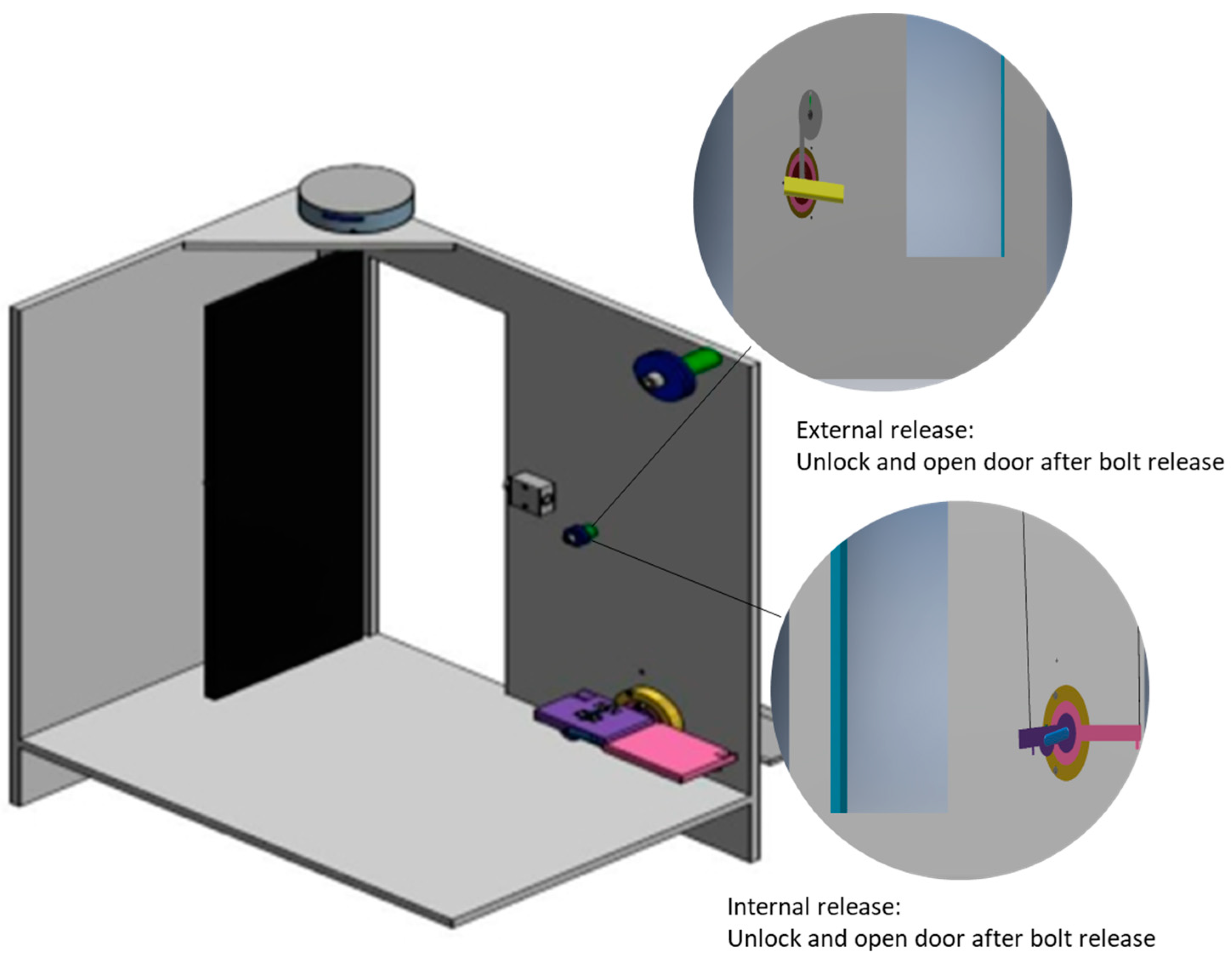
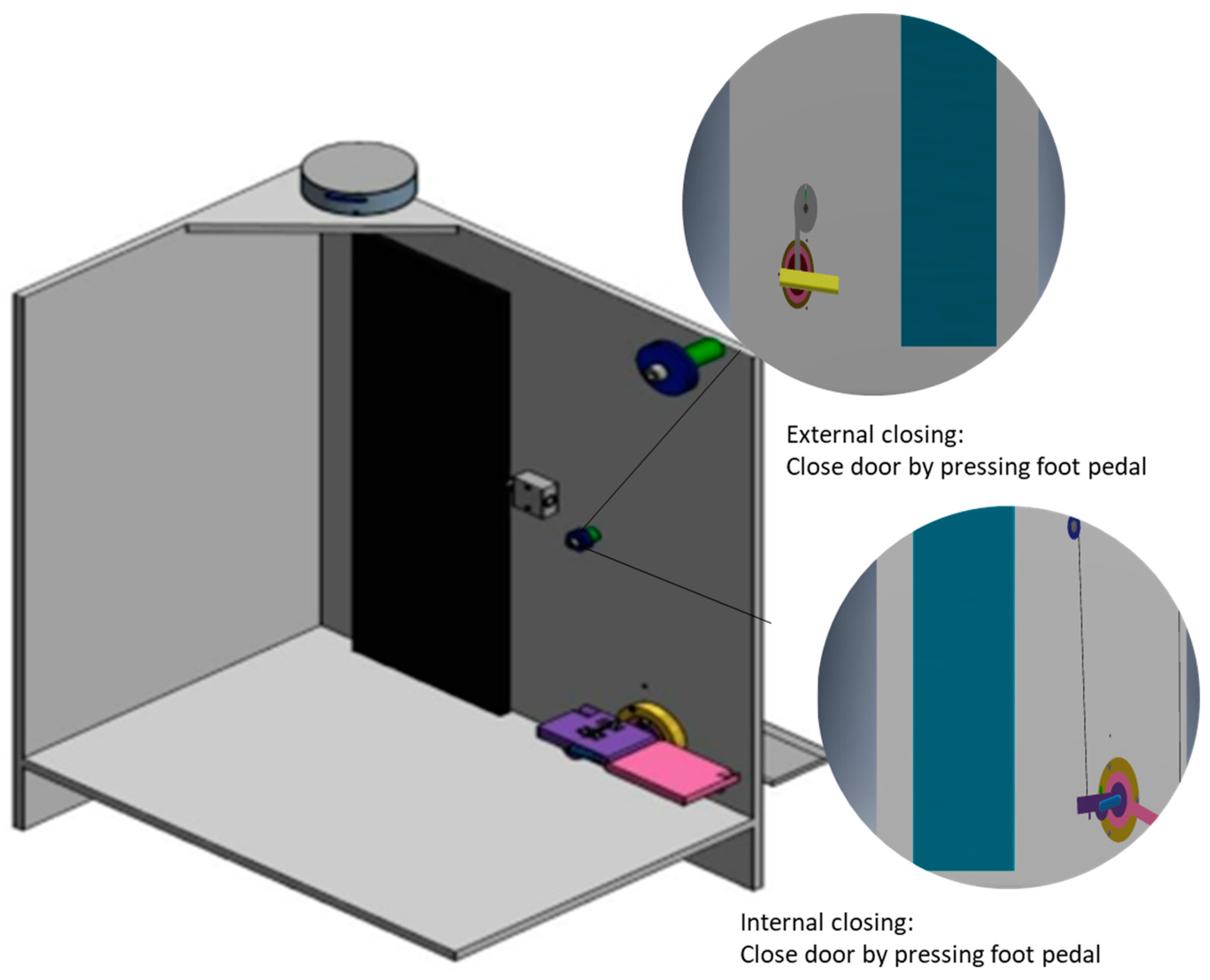

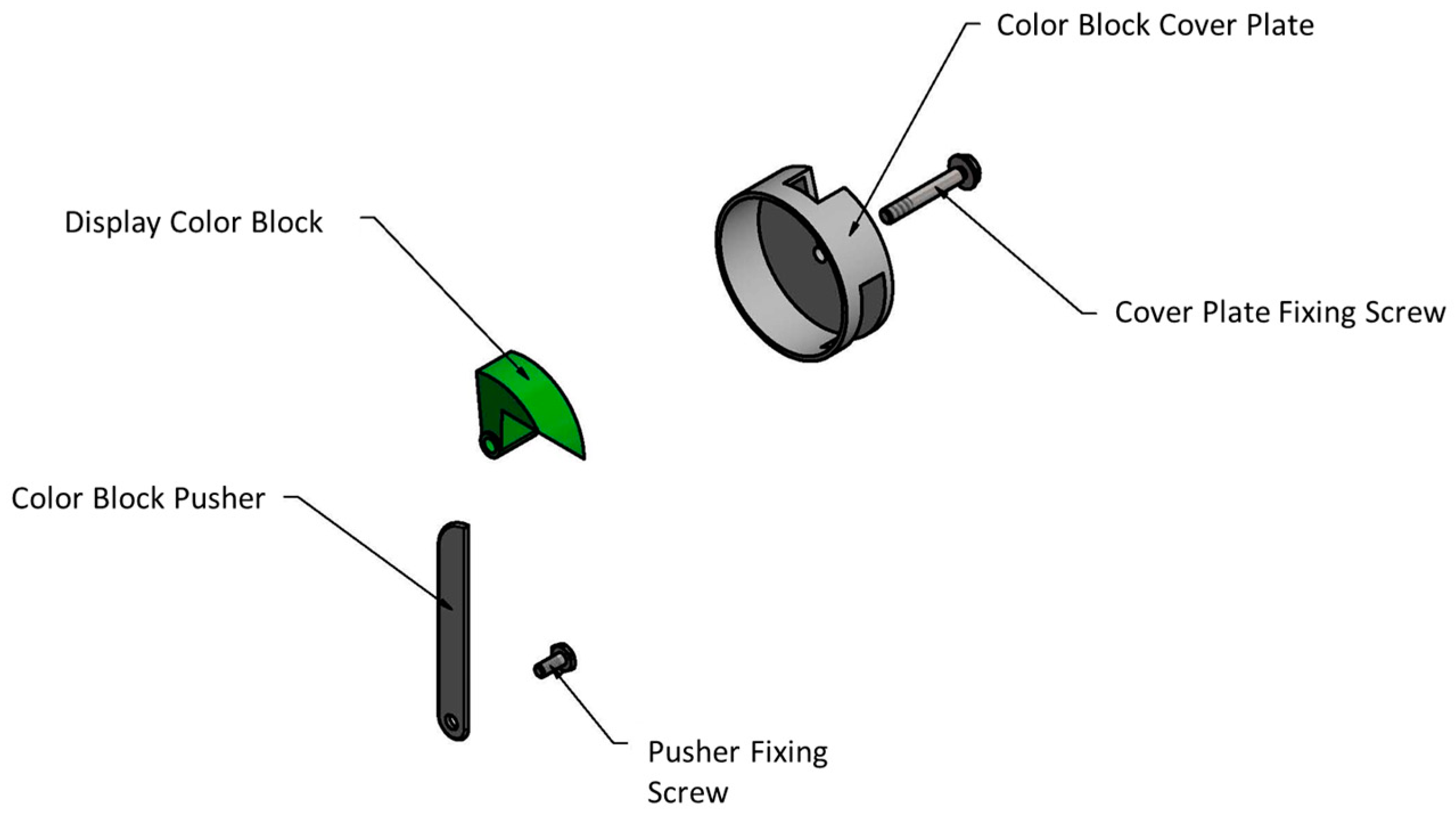
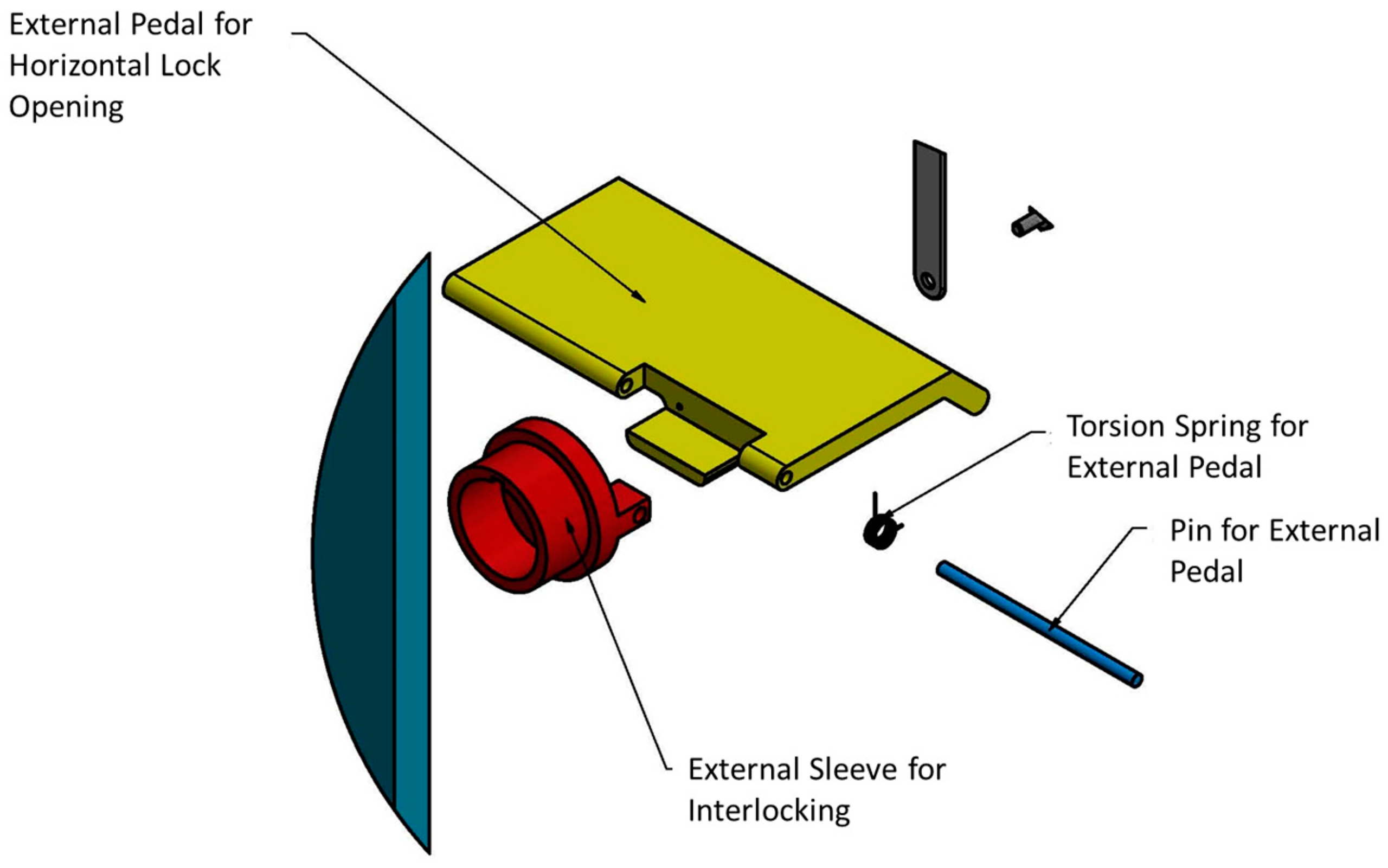
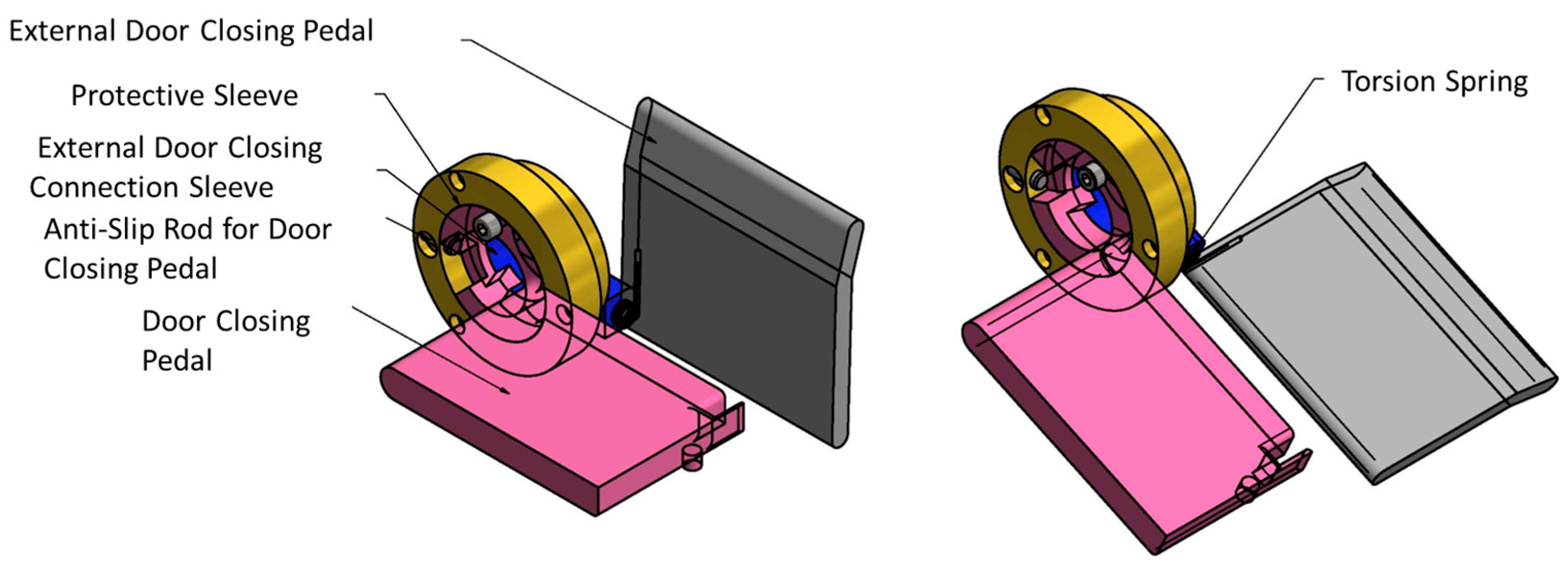
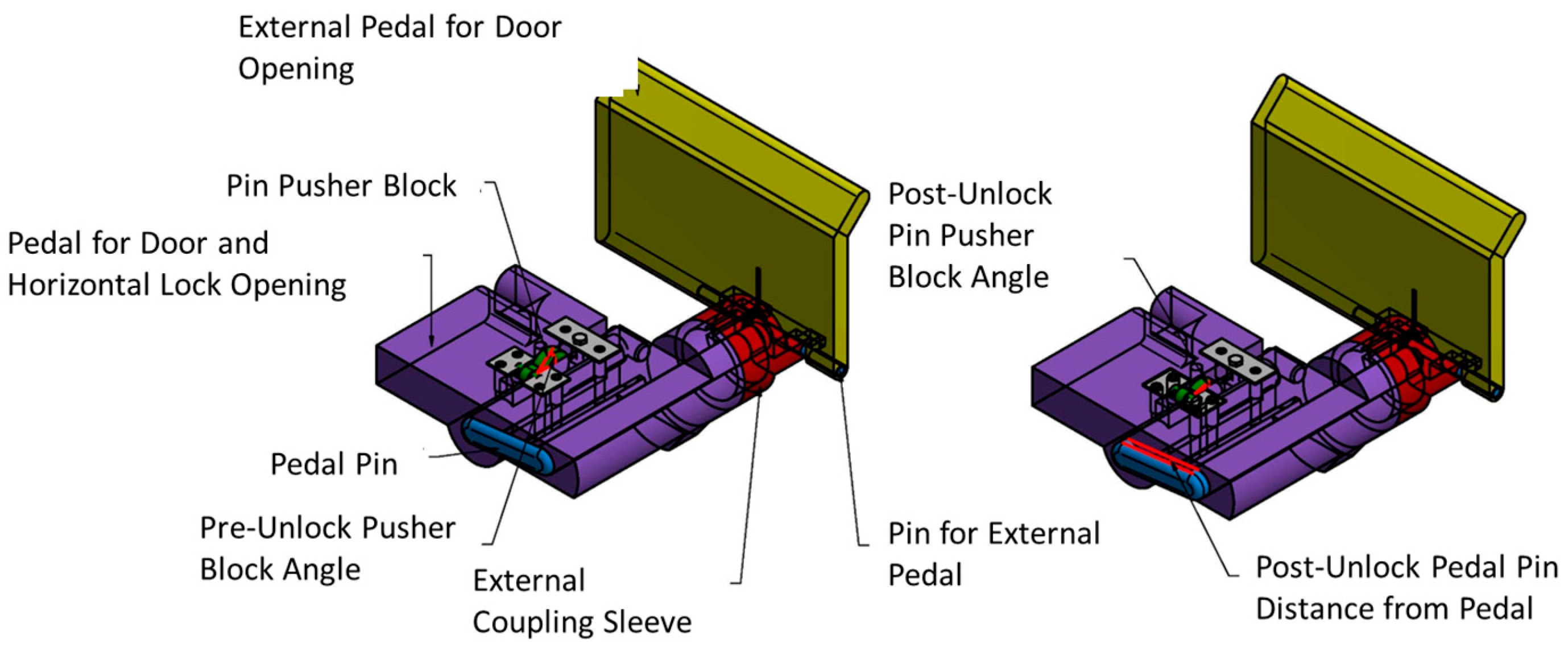
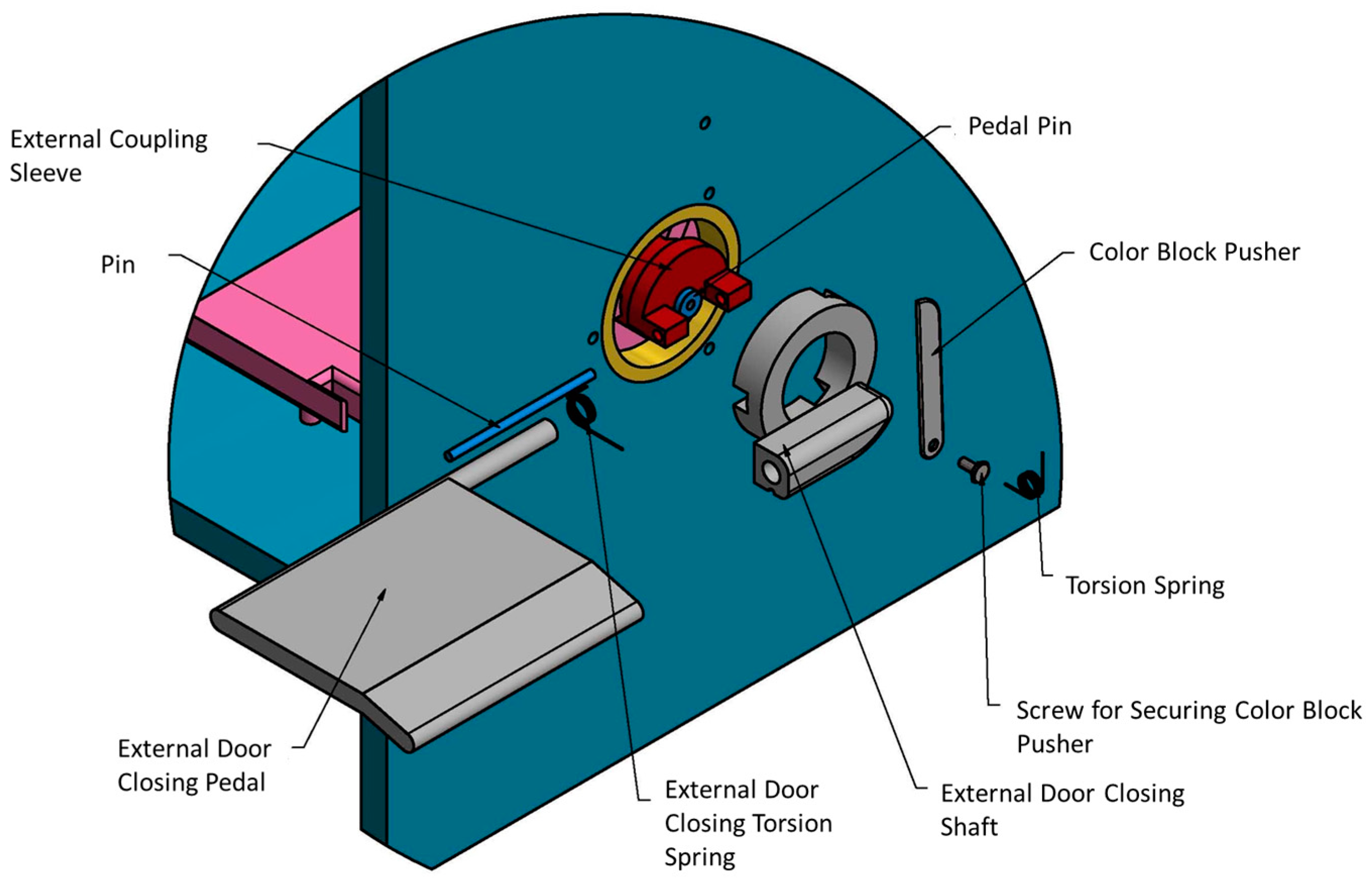

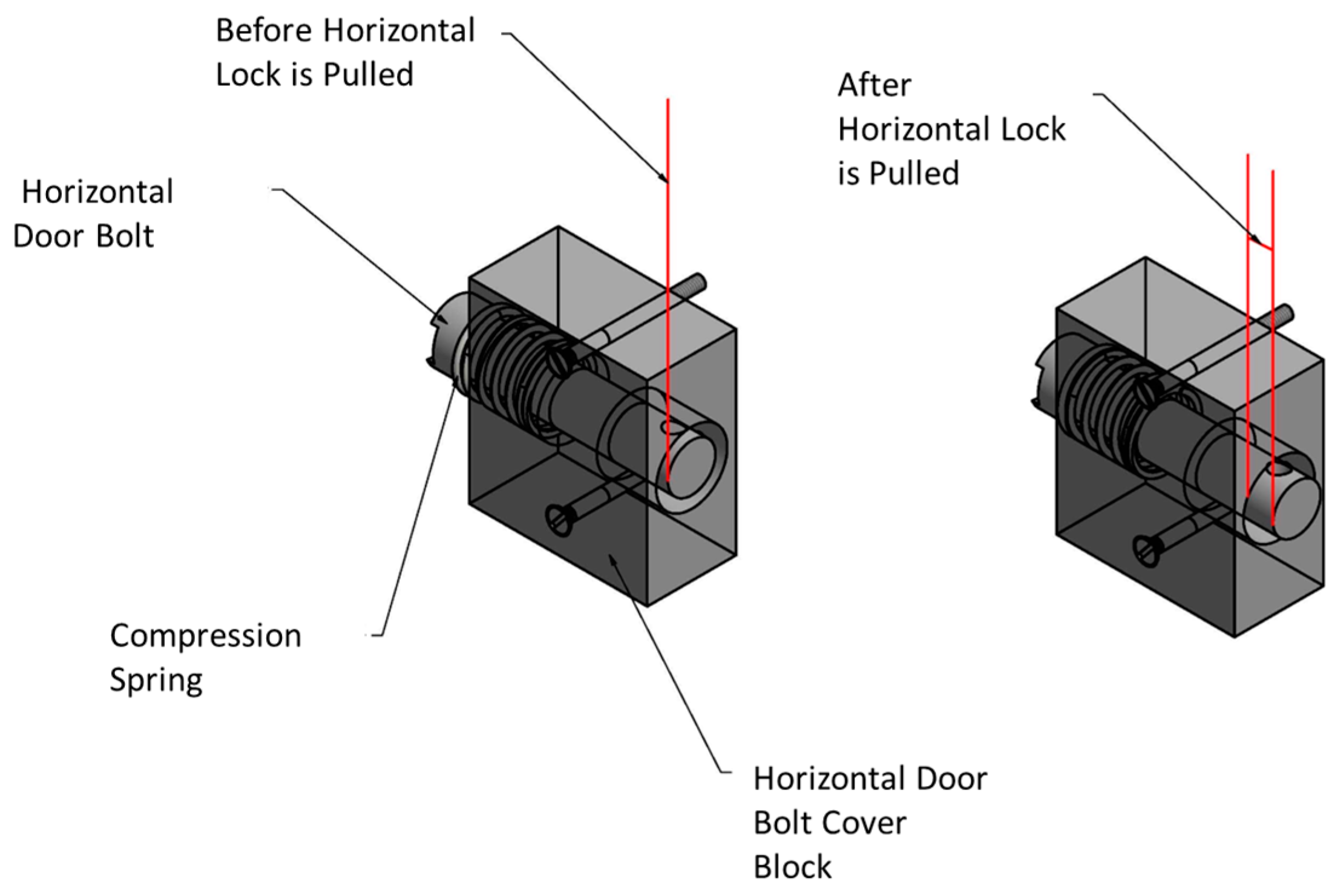
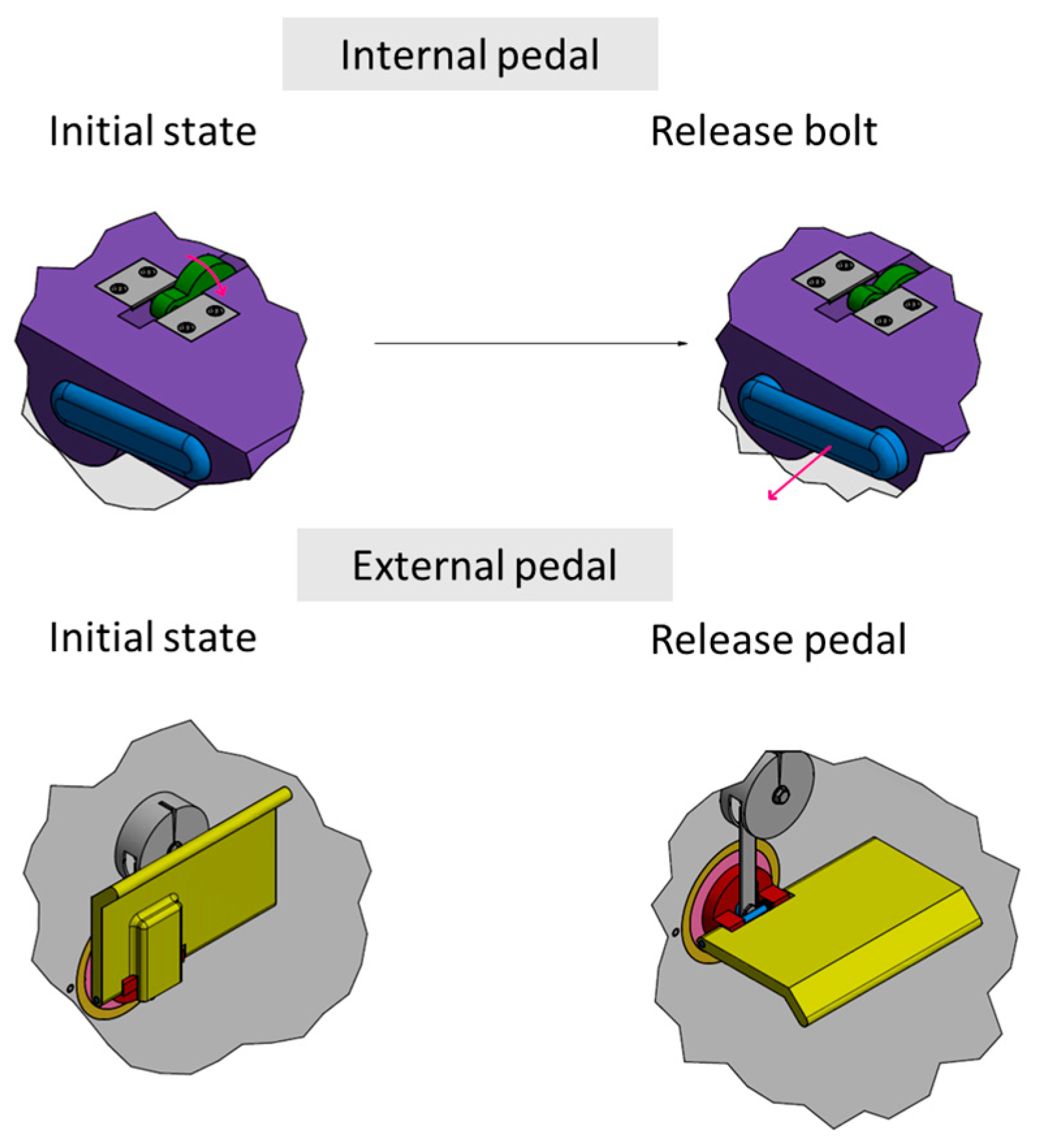


| Avoid Deterioration Parameters Want to Improve Parameters | 19. Energy Required for Moving Object | 22. Energy Consumption | 36. Device Complexity |
|---|---|---|---|
| 1. Weight of moving object | 35, 12 | 06, 02 | 26, 30 |
| 34, 31 | 34, 19 | 36, 34 | |
| 10. Force | 19, 17 | 14, 15 | 26, 35 |
| 10 | 10, 18 | ||
| 33. Ease of operation | 01, 13 | 02, 19 | 32, 26 |
| 24 | 13 | 12, 17 |
| Avoid Deterioration Parameters Want to Improve Parameters | 22. Energy Consumption | 31. Harmful Side Effects | 36. Device Complexity |
|---|---|---|---|
| 1. Weight of moving object | 06, 02 | 22, 35 | 26, 30 |
| 34, 19 | 31, 39 | 36, 34 | |
| 12. Shape | 14 | 35, 01 | 16, 29 |
| 01, 28 | |||
| 33. Ease of operation | 02, 19 | 32, 26 | |
| 13 | 12, 17 |
| Avoid Deterioration Parameters Want to Improve Parameters | 22. Energy Consumption | 31. Harmful Side Effects | 36. Device Complexity |
|---|---|---|---|
| 10. Force | 19, 17 | 13, 03 | 26, 35 |
| 10 | 36, 24 | 10, 18 | |
| 27. Reliability | 21, 11 | 35, 02 | 13, 35 |
| 27, 17 | 40, 26 | 01 | |
| 33. Ease of operation | 01, 13 | 32, 26 | |
| 24 | 12, 17 |
| Variables | Numbers | Percentage (%) | |
|---|---|---|---|
| Gender | |||
| Male | 115 | 52.27% | |
| Female | 105 | 47.73% | |
| Age | |||
| 20–29 | 37 | 16.82% | |
| 30–39 | 26 | 11.82% | |
| 40–49 | 82 | 37.27% | |
| >=50 | 75 | 34.09% | |
| Occupation | |||
| Business | 88 | 40.00% | |
| Education | 3 | 1.36% | |
| Engineering | 3 | 1.36% | |
| Housekeeping | 19 | 8.64% | |
| Manufacturing | 12 | 5.45% | |
| Government | 8 | 3.64% | |
| Service industry | 77 | 35.00% | |
| Student | 10 | 4.55% | |
| Education level | |||
| Junior hjigh school | 3 | 1.36% | |
| Senior high school | 78 | 35.45% | |
| University | 121 | 55.00% | |
| Graduate school | 18 | 8.18% | |
| Monthly income | |||
| <10,000 (TWD) | 15 | 6.82% | |
| 10,000–30,000 (TWD) | 57 | 25.91% | |
| 30,000–50,000 (TWD) | 70 | 31.82% | |
| 50,000–60,000 (TWD) | 38 | 17.27% | |
| >60,000 (TWD) | 40 | 18.18% | |
Disclaimer/Publisher’s Note: The statements, opinions and data contained in all publications are solely those of the individual author(s) and contributor(s) and not of MDPI and/or the editor(s). MDPI and/or the editor(s) disclaim responsibility for any injury to people or property resulting from any ideas, methods, instructions or products referred to in the content. |
© 2024 by the authors. Licensee MDPI, Basel, Switzerland. This article is an open access article distributed under the terms and conditions of the Creative Commons Attribution (CC BY) license (https://creativecommons.org/licenses/by/4.0/).
Share and Cite
Yao, K.-C.; Cheng, C.-N.; Li, K.-Y.; Xu, J.-R.; Huang, W.-L.; Ho, W.-S.; Liao, C.-W.; Yang, S.-C.; Hsiao, H.-L.; Lin, Y.-C.; et al. Sustainable Hygiene Solutions: Developing a Foot-Operated Door Mechanism for Communal Spaces Using TRIZ and Universal Design Principles. Sustainability 2024, 16, 8415. https://doi.org/10.3390/su16198415
Yao K-C, Cheng C-N, Li K-Y, Xu J-R, Huang W-L, Ho W-S, Liao C-W, Yang S-C, Hsiao H-L, Lin Y-C, et al. Sustainable Hygiene Solutions: Developing a Foot-Operated Door Mechanism for Communal Spaces Using TRIZ and Universal Design Principles. Sustainability. 2024; 16(19):8415. https://doi.org/10.3390/su16198415
Chicago/Turabian StyleYao, Kai-Chao, Chun-Nu Cheng, Kuo-Yi Li, Jing-Ran Xu, Wei-Lun Huang, Wei-Sho Ho, Chin-Wen Liao, Shu-Chen Yang, Hui-Ling Hsiao, Yin-Chi Lin, and et al. 2024. "Sustainable Hygiene Solutions: Developing a Foot-Operated Door Mechanism for Communal Spaces Using TRIZ and Universal Design Principles" Sustainability 16, no. 19: 8415. https://doi.org/10.3390/su16198415
APA StyleYao, K.-C., Cheng, C.-N., Li, K.-Y., Xu, J.-R., Huang, W.-L., Ho, W.-S., Liao, C.-W., Yang, S.-C., Hsiao, H.-L., Lin, Y.-C., & Lai, C.-Y. (2024). Sustainable Hygiene Solutions: Developing a Foot-Operated Door Mechanism for Communal Spaces Using TRIZ and Universal Design Principles. Sustainability, 16(19), 8415. https://doi.org/10.3390/su16198415






